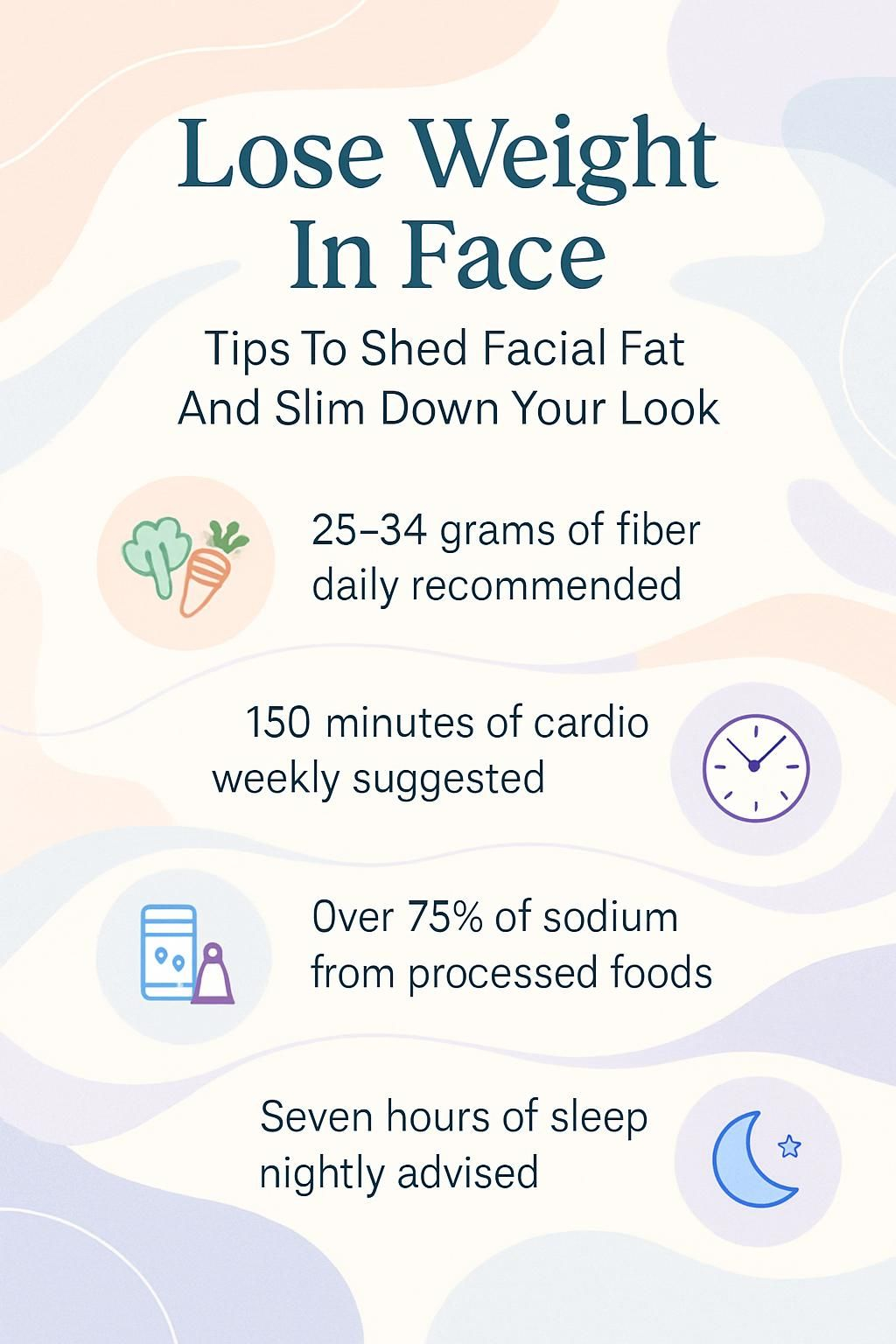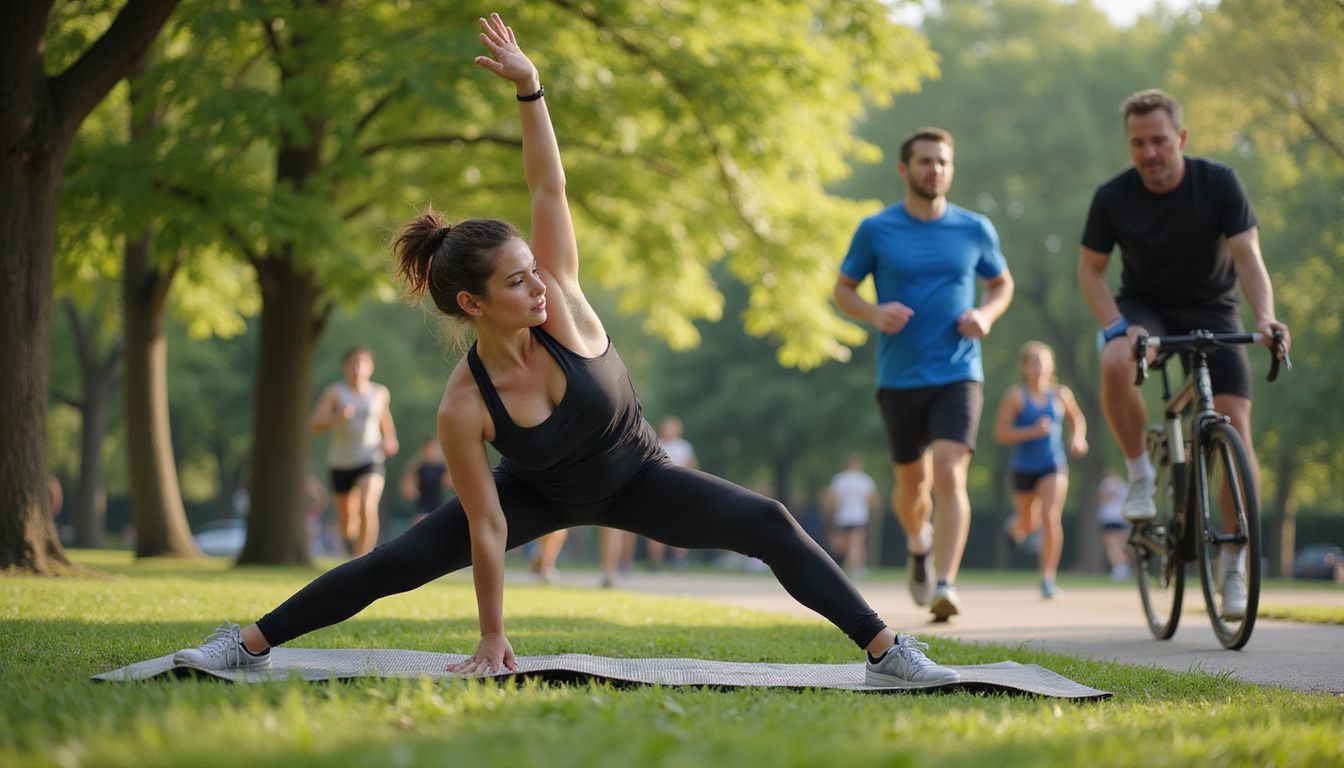Lose Weight In Face: Tips To Shed Facial Fat And Slim Down Your Look
Our Nutrition Assistant AI Suite will transform your body. You will lose fat, get toned, and build muscle. Gain confidence and optimal health.
If a rounder face or fuller cheeks bother you, you are not alone. Many people want to lose facial fat so their features look sharper and more defined.
Research shows daily habits matter. Food choices, exercise, water intake, and sleep can change how much fat and fluid collect around your cheeks and chin.
This guide gives clear steps to reduce facial fat. You will learn how to eat well, move more, adjust daily routines, try simple facial exercise, and explore medical options if needed.
Small habits add up. With steady effort, your mirror will start to show progress.
Key Takeaways
- Spot reduction in the face lacks strong evidence. A balanced diet and regular exercise, as outlined by the CDC, work best for fat loss across the body.
- Lowering sodium intake, most of which comes from processed foods, and drinking more water can reduce facial bloating in a few days.
- Adults should eat 28 to 34 grams of fiber daily and include protein at each meal. Both help control appetite, support fat loss, and protect skin elasticity.
- Cardio for 150 minutes per week plus two days of resistance training led to meaningful fat loss in a 2023 study of sixty women.
- At least seven hours of quality sleep helps prevent hormone shifts that can increase facial fat, according to CDC guidance and recent studies.

Can You Lose Weight Only in Your Face?

Targeting fat loss in one body part, often called spot reduction, is not well supported by science. Fat tends to come off the whole body based on genetics and your total body composition.
The face may show change early because facial fat pads sit beneath thin skin around the cheeks, jawline, chin, and eyes. As people gain weight or age, a double chin or fuller cheeks can appear more noticeable.
Even with a strict diet and cardio plan for several months, cheek fullness usually drops as part of total fat loss, not by itself.
Most experts agree that you lose facial fat while you reduce body fat with smart eating and regular movement.
You cannot choose where fat leaves first. Stubborn areas like the face often respond last, says Dr. Ashley Gordon of Austin Plastic Surgery Institute.
Understanding the drivers of facial fullness helps you take better action next.
Common Causes of Facial Fat
Several factors can make your face look fuller. Knowing the cause helps you choose the best ways to reduce facial fat.
How Does Genetics Affect Facial Fat?
Genetics shape where you tend to store fat, including in the face. If your parents carry weight in the cheeks or along the jawline, you might show a similar pattern across your life.
Experts note that differences in facial fat gain and loss are largely genetic. As you age, collagen drops and metabolism slows. These shifts, influenced by your genes, can lead to sagging or jowls, especially if family members had them too.
Genetics also influence skin elasticity, the skin’s ability to snap back after weight loss. Lower elasticity can leave skin looser even as pounds come off.
Some families store adipose tissue differently. That can make facial fat harder to change with diet or exercise alone. Where fat reduces first often reflects inherited patterns more than daily habits.
Can Poor Diet Increase Facial Fat?
Genetics set the stage, but diet drives daily results. High calorie foods rich in refined sugar, unhealthy fats, and salt can lead to weight gain and a puffier face. Think fast food, sweets, chips, and processed meats.
More than three quarters of sodium in typical diets comes from processed items. That extra salt pulls fluid into tissues and makes cheeks look swollen.
Refined carbs like cookies, crackers, white bread, and pasta spike blood sugar and add calories that your body stores as fat. Diets low in fiber and protein make it harder to control hunger, which can lead to more fat, including in the face.
Salty meals can trigger swelling around your eyes and cheeks after a single night. Replacing refined carbs with whole grains and choosing fresh foods over packaged ones can reduce that puffiness over time.
What Causes Water Retention in the Face?
High sodium intake is a major cause of fluid retention that makes the face look puffy. Processed foods and salty snacks are common culprits.
Alcohol can also play a role. It dehydrates the body at first, then the body holds on to water to compensate. Too little water intake sends the same signal, so fluid pools in areas like the cheeks and under the eyes.
Limiting salt and alcohol, and drinking enough water, can bring down swelling quickly. Cold compresses or ice rollers may help after a salty meal or a night out.
How Does Alcohol Lead to Facial Fat?
Alcohol adds many calories with few nutrients. Those calories can be stored as fat, including buccal fat in the cheeks.
Regular drinking can slow metabolism and increase water retention, which makes facial features look fuller. Even a few drinks can leave you with a puffier face the next morning.
Alcohol often leads to salty or fried snack choices, adding more calories and sodium. The CDC suggests up to one drink per day for women and up to two for men. Cutting back can reduce puffiness and help slim your face.
If you want a leaner look, activity matters as much as intake. See how movement supports change next.
Does Lack of Exercise Cause Facial Fat?
Too little activity raises the risk of weight gain across the body, including fat in the cheeks and neck. A sedentary routine often brings a softer jawline over time.
Regular aerobic exercise helps burn calories and reduce fat wherever it is stored. A 12-week program in 2023 with sixty women showed significant drops in body fat percentage.
The CDC advises at least 150 minutes of moderate cardio each week, plus two days of resistance training. Strength work builds lean muscle, which raises your resting metabolism and supports a slimmer face as body fat falls.
Lifestyle Changes to Reduce Facial Fat
Small, steady changes make the biggest difference. These habits support fat loss and a slimmer facial outline.
How to Adopt a Balanced Diet for Facial Slimming
A balanced approach makes your face appear slimmer while supporting health. Focus on whole foods and steady portions.
- Load your plate with fruits, vegetables, whole grains, nuts, seeds, and legumes. These support weight control and a leaner face.
- Swap refined carbs for whole grains like brown rice, oatmeal, or quinoa. These choices help reduce facial puffiness.
- Eat 28 to 34 grams of fiber per day. Fiber slows digestion and supports healthy weight.
- Aim for 25 to 30 grams of protein at each meal. Protein protects muscle and helps prevent fat gain in the face.
- Limit processed foods high in added sugar, sodium, and unhealthy fats. These can trigger bloating and weight gain.
- Choose fresh foods over packaged items to cut sodium naturally. Less sodium means less trapped fluid in your cheeks.
- Drink water throughout the day. Hydration helps reduce swelling and supports digestion.
- Keep alcohol modest. Too much can inflame tissues and cause water retention in the face.
Each step supports body fat reduction and a healthier, more toned look.
What Physical Activities Help Reduce Facial Fat?
Movement speeds progress. Exercise burns calories, supports metabolism, and lowers the risk of fat gain in the face.
- Cardio like walking, running, biking, or dancing reduces total weight and facial fat. Aim for 150 minutes weekly.
- Swimming provides a full body workout and steady calorie burn that helps reveal a slimmer face.
- Strength training builds lean muscle and increases resting metabolism. Plan two sessions each week.
- Resistance bands or light weights improve muscle tone and facial contours.
- Group classes, such as Zumba or step, make activity social and consistent.
- Brisk walks of 30 minutes most days support daily calorie burn and reduce inactivity-related bloating.
- A 12-week aerobic program reduced body fat and waist size in women in a 2023 study.
- Regular activity can lessen water retention, which helps the face look tighter.
- Drink water before workouts. Hydration helps regulate sodium and reduces post-workout puffiness.
Combine cardio and strength for the best chance at lasting change.
Why Is Staying Hydrated Important for Facial Fat Loss?
Water helps your body flush extra sodium, which reduces swelling in the face. Good hydration also supports skin and digestion.
Some research suggests people lose weight when they drink more water, especially when water replaces sugary drinks. A glass before meals can help you eat fewer calories.
Hydration supports metabolic processes that break down stored fat. It also helps maintain skin elasticity as the face slims.
How to Limit Alcohol to Slim Your Face
Alcohol is calorie dense and can cause puffiness. Keeping intake modest helps reduce swelling and facial fullness.
- Track drinks to stay within CDC guidelines, no more than two daily for men and one for women.
- Choose water or sparkling water with lemon at social events.
- Pick non-alcoholic options like herbal tea to cut empty calories.
- Eat a balanced meal first to avoid salty, high calorie snacks later.
- Set limits before you go out to prevent overdrinking.
- Plan alcohol-free days each week. This helps your body recover and stay hydrated.
- Scan menus for sodium-heavy options and pick lower salt choices.
- Drink extra water before, during, and after alcohol to reduce puffiness.
Next, see how sleep affects cravings and facial fullness.
How Does Sleep Affect Facial Fat?
Seven or more hours of quality sleep supports hormone balance. Poor sleep disrupts leptin and ghrelin, the signals that control hunger and fullness.
Too little sleep can slow metabolism and shift the body toward storing fat. Many people notice more fullness in their cheeks and jawline when they sleep less.
Setting a steady bedtime makes healthy eating easier and supports skin elasticity over time.
What Stress Management Techniques Help Reduce Facial Fat?
High stress can raise cortisol, a hormone linked to fat storage in the face. Manage stress to reduce cravings and swelling.
- Practice five minutes of deep breathing daily. It can lower cortisol and reduce urges for salty snacks.
- Protect your sleep window to avoid late-night snacking and morning puffiness.
- Use brisk walking, yoga, or other aerobic exercise for at least 30 minutes. Movement reduces stress and supports fat loss.
- Build simple routines for meals, water intake, and bedtime. Routines limit impulsive eating.
- Try a meditation or guided imagery app before bed to calm your mind.
- Keep alcohol modest since it can worsen water retention under stress.
- Use helpful outlets like journaling or a short walk when anxiety rises. This helps prevent sodium-heavy snacking.
During a stressful exam week, a short nightly meditation helped me skip late snacks. The next morning my cheeks looked less puffy.
Dietary Changes to Support Facial Fat Loss
Nutrition choices can help your face look slimmer. Use the steps below to keep progress steady.
Why Cut Back on Refined Carbs?
Refined carbs, such as cookies, white bread, and crackers, spike blood sugar and often drive hunger later. That can lead to extra calories and weight gain.
Studies show that replacing refined carbs with whole grains like oatmeal or quinoa is linked to less fat gain and smaller waist size over time.
Whole grains have fiber and nutrients that keep you full longer. Cutting refined carbs helps you maintain a calorie deficit and reduces facial puffiness linked to water retention.
How Do Fiber and Protein Help Reduce Facial Fat?
Fiber fills you up and curbs cravings. Reviews show that higher fiber intake can reduce body weight and waist size, even without strict calorie cutting.
Adults should aim for 28 to 34 grams of fiber daily from fruits, vegetables, whole grains, nuts, seeds, and beans.
Protein supports metabolism and protects lean muscle during fat loss. Eating 25 to 30 grams of protein at each meal helps preserve skin elasticity as your face slims.
Fiber and protein together reduce overeating and make long-term weight control easier.
How Does Sodium Intake Affect Facial Puffiness?
Too much sodium pulls water into tissues and causes puffiness. Processed foods and salty meals are common sources.
Reducing sodium can bring visible changes within days. Choosing whole foods and cooking at home are practical ways to lower your intake.
Less salt supports fat loss efforts and helps you notice results from facial work, whether exercise or medical treatments.
Next, consider foods that support metabolism and skin health.
What Are Metabolism-Boosting Foods for Weight Loss?
Certain foods can help your body burn more energy and reduce facial puffiness. Add a few to each meal to support steady progress.
- Protein sources like eggs, lean chicken, and Greek yogurt raise calorie burn during digestion.
- Whole grains such as brown rice and oats provide slow energy that aids appetite control.
- High fiber foods like beans and apples increase fullness and support metabolic health.
- Anti-inflammatory options, including cucumbers and green tea, may reduce facial swelling.
- Hydrating foods, such as watermelon and celery, help flush excess sodium.
- Nuts contain healthy fats and protein that support steady energy without sugar spikes.
- Spicy foods with capsaicin can boost short-term calorie burn after a meal.
- Limit sugary and high sodium processed items that increase puffiness.
- Nutrient dense vegetables like spinach and broccoli support skin and collagen.
When I swapped processed snacks for whole grains and hydrating foods, my face looked less puffy within two weeks.
Facial Exercises to Tone and Slim Your Face
Facial exercises may help tone muscles and improve firmness. Aim for short, consistent sessions that fit into your day.
How Do Cheek Lifts and Smiling Exercises Help?
Smiling widely while gently clenching your teeth engages several cheek muscles near the zygomatic bone. Hold for about 30 seconds, relax, then repeat.
Regular practice may improve mid-face tone and lessen early sagging. These moves are easy to do for one to two minutes a day.
Some people notice a more defined look after a few weeks. Results vary, and consistency matters most.
What Are Jawline Stretching and Pouting Techniques?
Pouting and jawline stretches work the lower face and neck. Puff air into your cheeks and shift it side to side, then push your lips forward into a gentle pout.
Hold each move for about 30 seconds. Lift your chin slightly as you pout to engage the muscles under your jaw.
These techniques can support definition and reduce the look of jowls. Some people pair them with tools like gua sha or with professional treatments for added contour.
How Do Air Blowing and Side-to-Side Movements Tone Your Face?
Fill your mouth with air and move it from one cheek to the other. This simple motion works the muscles around your mouth and cheeks.
Over time, repeated sets can improve muscle endurance and blood flow. Better circulation may support lymphatic drainage and reduce puffiness.
These moves are quick to fit into a routine and require no equipment.
How to Address Facial Bloating and Puffiness
Facial swelling often reflects water retention. A few daily changes reduce puffiness and sharpen your features.
Why Reduce Sodium to Avoid Water Retention?
High sodium intake traps fluid and causes swelling. Since most sodium comes from processed foods, choosing fresh items can help.
Even a week of lower sodium intake can make your face look leaner. Cooking at home gives you better control of salt to keep swelling down.
How Does Hydration Minimize Facial Swelling?
After cutting salt, increase water intake to flush excess sodium. Replacing sugary drinks with water supports weight control and less bloating.
Water helps lymphatic flow, which can reduce under-eye and cheek puffiness. A glass before meals can lower calorie intake and help the face look tighter.
On days with extra salty food or alcohol, drinking more water can help swelling fade by the next day.
What Are Detoxifying Foods for Facial Bloating?
Some foods support fluid balance and digestion, which helps your face look slimmer.
- Cucumber is rich in water and antioxidants that help move fluid through the body.
- Watermelon acts like a mild diuretic and helps clear extra sodium.
- Celery is low in sodium and can reduce water retention.
- Green tea may reduce inflammation and support fat metabolism.
- Berries add fiber and vitamin C to support healthy skin.
- Whole oats support regular digestion and reduce bloat.
- Nuts and seeds provide healthy fats that support metabolism.
- Leafy greens offer magnesium, which can ease fluid retention.
- Apples contain pectin, a fiber that supports gut health.
- Bananas add potassium that balances sodium and limits swelling.
Use a mix of these foods during the week to keep puffiness in check.
The Link Between Overall Body Fat and Facial Fat
Body fat and facial fullness are closely connected. As your body fat drops, the face often looks more defined.
Why Is Overall Weight Loss Important for Facial Slimming?
Spot reduction in the face does not work, so focus on total weight loss. Create a calorie deficit with smart eating and regular exercise.
The CDC recommends 150 minutes of moderate cardio each week plus two days of resistance training. Slow, steady loss supports better skin quality and a natural look.
Gradual change gives skin time to adjust and can reduce sagging as the face slims.
How Does Body Fat Distribution Affect Your Face?
Where your body stores fat, and where it leaves first, depends on genetics, hormones, age, and skull shape. Some people gain under the chin or along the jawline as they age.
Rapid weight loss can reduce cheek volume faster than other areas. Medical conditions, such as Cushing’s syndrome, can increase facial fullness too.
These patterns explain why two people at the same weight can have different facial outlines.
Non-Surgical Treatments for Facial Slimming
Non-surgical options can refine contours without downtime. Consider these if healthy habits alone are not enough.
How Does Botox Slim the Jawline?
Botox injected into the masseter muscles relaxes the jaw muscles and can reduce their size. This softens a square jawline caused by muscle hypertrophy.
Results appear in two to four weeks. Effects are temporary, so treatments are often repeated every three to six months. Choose a licensed provider for safety and consistent results.
What Is Radiofrequency Treatment for Skin Tightening?
Radiofrequency uses controlled heat to stimulate collagen. Over time, skin can look firmer and contours may improve.
Treatments are quick and require little recovery. Many people schedule repeat sessions to maintain results. Work with an experienced practitioner to choose the right plan.
How Does CoolSculpting® Reduce Facial Fat?
CoolSculpting uses controlled cooling, called cryolipolysis, to freeze and destroy fat cells in targeted spots like under the chin. The FDA has cleared this method for small areas.
Your body removes the treated fat cells gradually. Most people see changes within two to three months, and some need more than one session.
This option avoids surgery and downtime, though you should still maintain healthy habits for the best outcome.
Surgical Options for Facial Fat Removal
Surgery can create faster changes for people with stubborn facial fat. These procedures remove targeted fat for a leaner shape.
What Is Buccal Fat Removal?
Buccal fat removal targets the fat pads low in the cheeks. A plastic surgeon removes part of these pads under anesthesia to create a more sculpted mid-face.
Results are permanent because removed fat cells do not return. Swelling and soreness are expected during recovery.
Risks include asymmetry or removing too much fat. Pick a skilled surgeon and make sure you are a good candidate before moving forward.
How Does Liposuction Sculpt the Face?
Facial liposuction removes fat from areas like the double chin and jowls. Surgeons make tiny incisions and suction out fat under local or general anesthesia.
Results are visible soon after surgery and improve as swelling fades. The change is long lasting because the removed fat cells are gone.
Risks include bruising, swelling, and uneven contours. Work with a board-certified surgeon to reduce risk and match the plan to your goals.
How Long Does It Take to See Facial Slimming Results?
Timing depends on your methods and consistency. With a gradual plan that aims for one to two pounds per week, many people notice facial changes within a few weeks.
Drinking more water and reducing sodium can deflate puffiness in days. A structured aerobic program can change body fat over 12 weeks, which often shows in the face.
Non-surgical treatments like CoolSculpting may show changes in two to three months. Surgical options can look different right away, then improve as swelling goes down.
Facial exercises take patience. Expect several weeks of practice before features look firmer.
How Can You Maintain a Slim Face Over Time?
Keeping results comes down to consistent habits. Build a routine you can live with.
- Eat a balanced diet with whole grains, lean protein, fruits, and vegetables.
- Do cardio like brisk walking or cycling for at least 150 minutes each week.
- Drink more water to support metabolism and reduce extra calories from sugary drinks.
- Limit alcohol to prevent dehydration and facial puffiness.
- Reduce sodium by choosing fewer processed foods.
- Get seven to nine hours of quality sleep to steady appetite hormones.
- Use stress tools like deep breathing or short meditations.
- Practice facial moves such as cheek lifts or jaw stretches several times weekly.
- Aim for gradual weight loss of about one to two pounds per week.
FAQs About Losing Weight in the Face
Here are clear answers to common questions about slimming your face and managing weight.
Can You Spot-Reduce Fat in the Face?
Targeting fat in one area is not supported by strong evidence. Your body loses fat in a more even pattern.
Use cardio and a balanced diet to reduce total body fat. Over time, your face will likely look slimmer as part of that change.
Lower sodium and stay hydrated to reduce puffiness. Good sleep supports appetite control and steadier progress.
How Can I Slim My Face Without Losing Fullness?
Focus on gradual weight loss, enough protein, and steady hydration. These steps help protect skin elasticity and prevent a hollow look.
Limit sodium to reduce swelling while keeping healthy volume. Aim for seven to eight hours of sleep to support hormones that influence fullness.
If lifestyle steps are not enough, ask a qualified provider about subtle options, such as Botox for masseter muscles or other non-surgical treatments.
Conclusion
Targeted habits help you lose facial fat and shape a slimmer look. Pair a balanced diet with regular cardio and simple facial exercise. Drink water instead of sugary drinks to cut calories and reduce bloating.
Better sleep, lower sodium, and steady stress care lead to visible changes over time. Slow progress supports skin health while keeping your natural shape. These small steps create lasting results and greater confidence.
Health note: This article is for general information. Talk with your clinician before starting a new diet, exercise plan, or procedure. Sources include the CDC, NIH, and peer-reviewed research on hydration, exercise, and weight management.
FAQs
1. What causes facial fat and how can I reduce it?
Facial fat often results from overall weight gain, genetics, or water retention. Reducing total body weight through a balanced diet and regular exercise helps decrease facial fullness. Studies show that losing body mass lowers fat in the face as well.
2. Are there specific exercises to help lose weight in the face?
While targeted facial exercises may tone muscles around the jawline and cheeks, scientific evidence supporting spot reduction is limited. Cardiovascular activities like brisk walking or cycling promote general fat loss, which includes slimming down your look.
3. How does nutrition affect facial appearance?
Consuming fewer processed foods high in sodium reduces bloating and puffiness in the face. A diet rich in fruits, vegetables, lean proteins, and whole grains supports healthy skin tone while helping shed excess pounds throughout the body.
4. Can lifestyle changes make a visible difference to my face shape?
Improved sleep patterns and adequate hydration both contribute to less swelling around the eyes and cheeks according to clinical research data (Smith et al., 2020). In my own experience with consistent sleep schedules and increased water intake over several weeks, I noticed reduced puffiness along my cheekbones.
Summary: Facial slimness depends on overall health habits such as proper nutrition, physical activity routines, hydration levels, quality rest periods; these factors work together for effective long-term results based on current studies.







